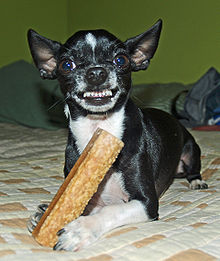Understanding Why Dogs Yawn – Hint…It's Not ALWAYS Because They're Tired!
There is no doubt that a dog is really man's best friend. These
adorable furry creatures are loving, loyal and never cease to provide
their human family with endless joy and companionship. The pet will
stick with you through thick and thin. Dogs are known to ape what their
masters do. It is really quite amusing to see that a dog will empathize
with the master even with yawning. A master coming in from the office
very tired will yawn; the dog can be seen yawning too.
A misconception that dogs yawn because they're tired, as we would do,
can actually lead to problematic encounters. Because a dog yawn can
actually be a precursor to something much more serious in the way of anxiety, fear and even a bite.
People yawn when they are bored, sleepy and fatigued. Interestingly,
foetuses that are 12 weeks old are seen yawning. Yawning in dogs
however, has no definitive reason. When we see our pets yawn we take it
for granted that their reason for yawning is pretty much the same as the
reason why we do.
Scientists have theorized that dogs yawn when they are bored.
If you are an observant pet owner you will see at once that the pet is
bored. Most often the dog will look at you with imploring eyes, yawn and
then flop to the ground. The dog is telling you "come on, play with me"
A yawning dog with a tense and rigidly held body is a sign that the
dog is nervous. This reaction is often seen in obedience classes where
the dog is pressured. The dog wants to please the master but does not
know how. If you are training your dog and you noticed him yawning, you
better let up. Proceeding with the training will not have positive
results anyway. Let the dog rest for a while and encourage with verbal
praises.
Excitement is another reason why dogs yawn. Dogs in agility
competitions are often noted yawning. This is the dogs way of coping
with the excitement. A dog in the starting line is ready and raring to
go to scale the obstacle. By yawning, the dog is preparing its body for
the action. The deep breaths fill the lungs and boost the flow of oxygen
to the brain. This also increases the heart rate. Really quite amazing
how the dog will cope with situations such as this!
Commonly, dogs yawn because they are tired and sleepy. Yawning is
precursor to sleeping. Dogs like cats sleep a lot so it will not be an
extraordinary thing to see your pet yawning.
Studies have proven that yawning is contagious. If you yawn, somebody
else will yawn too. Dog handlers have used the fact that yawning can
energize, calm and relax a dog. By yawning, they can induce the pet to
yawn too.
Find out more about why dogs yawn and many other interesting
questions about dogs at Sarah's Dogs. Sarah's Dogs has profiles of most
common and many rare breeds as well as answers to common questions on
dog behaviour.
Understanding dog yawns can also be crucial in potentially avoiding being attacked by a dog.
As yawning can be such a visual display of stress or anxiety, if you
happen to notice a dog is constantly yawning when you approach it or
even petting it (especially on the head), this could be a stress signal
coming from the dog.
A guide to canine mouth signals:
1. Mouth relaxed and slightly open, tongue may be slightly
visible or even slightly draped over the lower teeth: This is the dog
equivalent of the human smile. It means "I am happy and relaxed."
2. Yawn: While it is usually interpreted by humans as meaning
fatigue or boredom, it can actually be a stress-related signal, best
interpreted as "I am tense or anxious."
3. Lips curled to expose some teeth, mouth still mostly closed: "You are annoying me!" This is the first sign of menace or threat.
4. Lips curled up to show major teeth, some wrinkling of the
area above the nose, mouth partly open: "If you do something that I
might interpret as a threat, I may bite." This is the next stage of
threat but may also indicate fearfulness. Pressing a dog at this stage
may lead to an aggressive attack.
5. Lips curled up to expose not only all of the teeth but also the gums above the front teeth,
visible wrinkles above the nose: "Back off!" This is the full threat
display that indicates a dog is ready to release a violent attack. If
you are ever confronted with this display, you should not turn and run:
the level of arousal is so high that your movement will probably produce
a pursuit-and-attack response. Instead, cast your gaze slightly down (a
slightly submissive eye position), open your mouth a bit (a bit of a
counter-threat), and back off slowly.
Source - mydogmagazine.com
Article by K9 Magazine

No comments:
Post a Comment